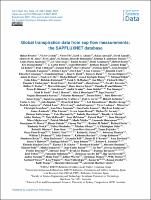| dc.contributor.author | Poyatos, Rafael | |
| dc.contributor.author | Granda, Víctor | |
| dc.contributor.author | Flo, Víctor | |
| dc.contributor.author | Adams, Mark A | |
| dc.contributor.author | Adorján, Balázs | |
| dc.contributor.author | Aguadé, David | |
| dc.contributor.author | Aidar, Marcos P.M. | |
| dc.contributor.author | Allen, Scott | |
| dc.contributor.author | Alvarado-Barrientos, Susana | |
| dc.contributor.author | Anderson-Teixeira, Kristina J. | |
| dc.contributor.author | 152 autores más | |
| dc.date.accessioned | 2020-11-19T04:16:33Z | |
| dc.date.available | 2020-11-19T04:16:33Z | |
| dc.date.issued | 2020 | |
| dc.identifier.uri | https://repositorio.catie.ac.cr/handle/11554/9995 | |
| dc.description.abstract | Plant transpiration links physiological responses of vegetation to water supply and demand with hydrological, energy and carbon budgets at the land-atmosphere interface. However, despite being the main land evaporative flux at the global scale, transpiration and its response to environmental drivers are currently not well constrained by observations. Here we introduce the first global compilation of whole-plant transpiration data from sap flow measurements (SAPFLUXNET, https://sapfluxnet.creaf.cat/). We harmonised and quality-controlled individual datasets supplied by contributors worldwide in a semi-automatic data workflow implemented in the R programming language. Datasets include sub-daily time series of sap flow and hydrometeorological drivers for one or more growing seasons, as well as metadata on the stand characteristics, plant attributes and technical details of the measurements. SAPFLUXNET contains 202 globally distributed datasets with sap flow time series for 2714 plants, mostly trees, of 174 species. SAPFLUXNET has a broad bioclimatic coverage, with woodland/shrubland and temperate forest biomes especially well-represented (80% of the datasets). The measurements cover a wide variety of stand structural characteristics and plant sizes. The datasets encompass the period between 1995 and 2018, with 50% of the datasets being at least 3 years long. Accompanying radiation and vapour pressure deficit data are available for most of the datasets, while on-site soil water content is available for 56% of the datasets. Many datasets contain data for species that make up 90% or more of the total stand basal area, allowing the estimation of stand transpiration in diverse ecological settings… | es_ES |
| dc.language.iso | en | es_ES |
| dc.relation.ispartof | Earth System Science Data | es_ES |
| dc.rights | info:eu-repo/semantics/openAccess | es_ES |
| dc.subject | BASES DE DATOS | es_ES |
| dc.subject | FLUJO | es_ES |
| dc.subject | SAVIA | es_ES |
| dc.subject | ECOSISTEMA | es_ES |
| dc.subject | USO DEL AGUA | es_ES |
| dc.subject | ECOLOGIA | es_ES |
| dc.subject | TRANSPIRACION | es_ES |
| dc.subject | CUENCAS HIDROGRAFICAS | es_ES |
| dc.subject | ECOFISIOLOGIA | es_ES |
| dc.subject | AGRONOMIA | es_ES |
| dc.subject | HIDROLOGIA | es_ES |
| dc.title | Global transpiration data from sap flow measurements: the SAPFLUXNET database | es_ES |
| dc.title.alternative | Datos de transpiración global de las mediciones del flujo de savia: Base de datos SAPFLUXNET | |
| dc.type | Artículo | es_ES |


